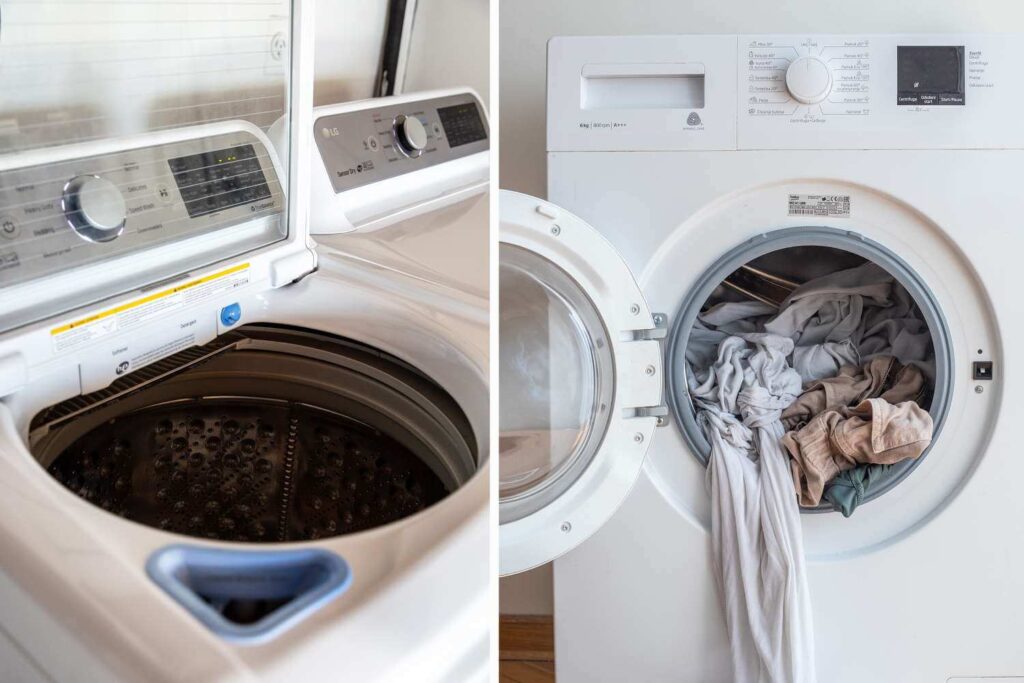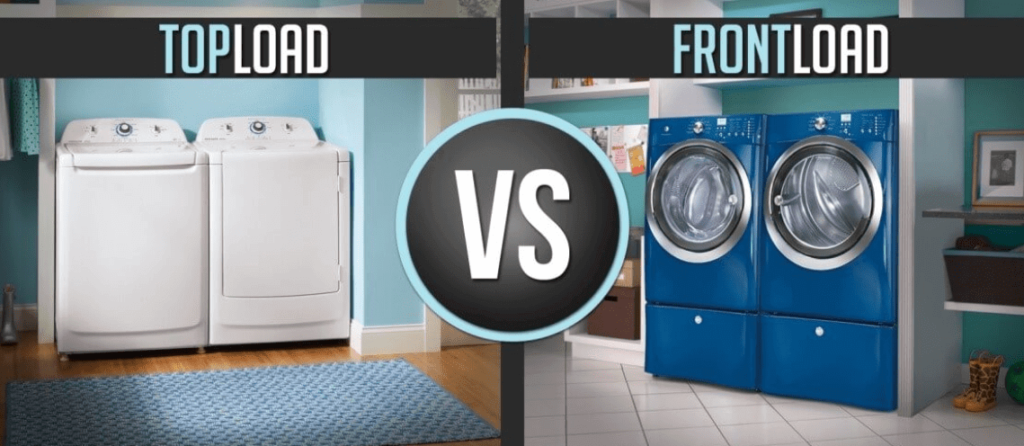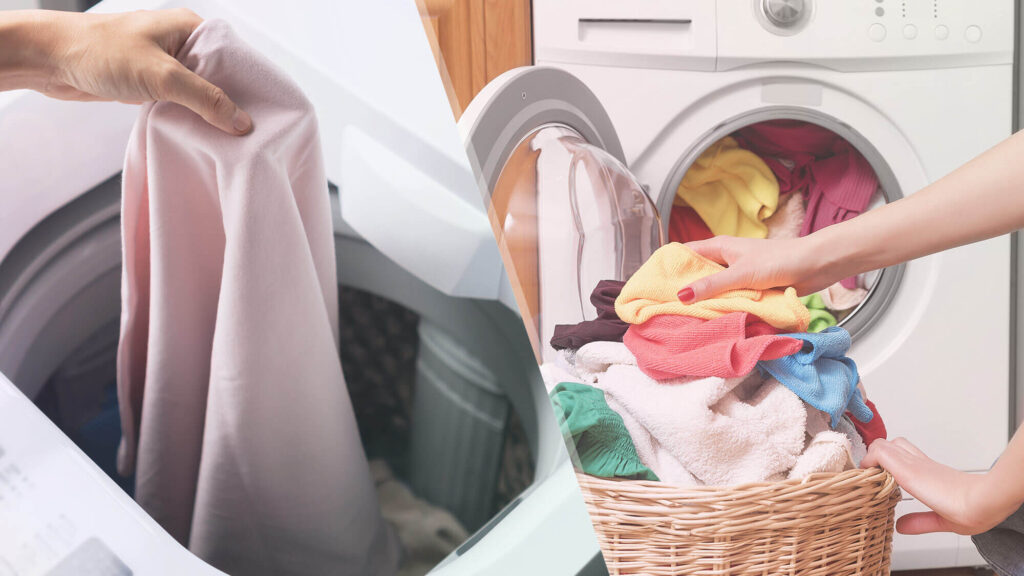
Laundry day – the inevitable chore that awaits us all. But fret not, for your trusty washing machine is here to make life easier. Whether you’ve got a sleek front-loading washer or a classic top-loading workhorse, keeping these laundry heroes in tip-top shape is crucial. But what’s the real deal with maintaining these machines, and is there a significant difference between front-loading and top-loading washers in terms of upkeep? In this comprehensive guide, we’ll delve deep into the world of washer maintenance, providing you with a wealth of tips to ensure your laundry buddy stays in peak condition.
Understanding the Basics: Front-Loading vs. Top-Loading
Before we roll up our sleeves and dive into the world of washer maintenance, let’s get the lowdown on the fundamental differences between these two laundry champions:
Front-Loading Washers
Front-loading washers are the epitome of space-saving design and efficiency. Here’s what sets them apart:
- Space Saver Extraordinaire: Front-loading washers boast a slim and sleek design, making them the ideal choice for those looking to maximize space in tight laundry rooms or closets.
- Water and Energy Efficiency: These machines are renowned for their water and energy efficiency. They use less water and energy compared to their top-loading counterparts, making them an eco-friendly choice.
- Gentle on Fabrics: The drum in a front-loading washer rotates horizontally. This gentle motion means less wear and tear on your clothes, making them perfect for delicate fabrics.
Top-Loading Washers
Top-loading washers, on the other hand, are the tried-and-true classics that have been a staple in households for generations. Here’s what makes them stand out:
- Old-School Reliability: Top-loaders are known for their straightforward operation and dependable performance. They’ve been around the block and have proven their mettle.
- Quick and Easy: One of the top advantages of a top-loading washer is the ability to toss in forgotten laundry mid-cycle. No more waiting for the drum to unlock – just pop the lid and add what you missed.
- Budget-Friendly: If you’re on a tight budget, top-loading machines often come with a more wallet-friendly price tag, making them a popular choice for many.
Now that we’ve covered the basics let’s dive into the nitty-gritty of maintaining these machines, starting with front-loading washers.
Front-Loading Washer Maintenance Tips

Front-loading washers are known for their exceptional efficiency and gentle fabric care, but they do require specific maintenance to keep them in top form.
The Rubber Seal Dilemma
One of the most common issues with front-loading washers is the rubber seal around the door. This rubber gasket can trap moisture, leading to mold and unpleasant odors. Here’s how to tackle this problem:
Maintenance Task: Clean the Gasket Regularly
- How to Do It: Wipe the rubber gasket down with a mixture of water and vinegar. Pay close attention to reaching hidden spots where moisture can accumulate. A monthly cleaning routine can help prevent mold growth.
Maintenance Task: Keep the Door Ajar
- How to Do It: After a wash, leave the washer door slightly open. This simple act allows for better air circulation within the drum and door seal, effectively preventing mold growth.
Detergent Drawer Drama
Front-loading washers often come equipped with detergent and fabric softener drawers. Over time, these drawers can become a breeding ground for gunk and residue. Here’s how to maintain them:
Maintenance Task: Regular Drawer Detox
- How to Do It: Periodically, pull out the detergent drawer and give it a thorough rinse. If you encounter stubborn residue, use an old toothbrush to scrub it off, ensuring that every nook and cranny is pristine.
Filter Fiasco
Front-loading washers also feature a filter that can easily get clogged with lint and debris. A blocked filter can force your machine to work harder and reduce its efficiency. Here’s what you need to do:
Maintenance Task: Locate the Filter
- How to Do It: Check your washer’s user manual to find out where the filter is located, as it can vary from one model to another.
Maintenance Task: Regular Check-Ups
- How to Do It: Every few months, remove the filter, clean it out thoroughly, and then put it back in place. This simple maintenance task can prevent clogs and ensure your washer operates smoothly.
Top-Loading Washer Maintenance Tips

Top-loading washers, while known for their reliability, also require proper care to keep them in top condition. Here are some essential maintenance tips for these classic machines:
Lid Love
In the world of top-loading washers, it’s all about the lid. Ensuring the lid is in tip-top condition is crucial for both safety and smooth operation. Here’s what you need to do:
Maintenance Task: Inspect the Lid Switch
- How to Do It: The lid switch is a safety feature that prevents your washer from running with the lid open. Regularly check if the switch is working properly to ensure your safety and the washer’s functionality.
Maintenance Task: Clean the Lid and Edges
- How to Do It: Wipe down the lid and the edges to prevent the buildup of dirt and grime. This simple act can help maintain a clean and safe washing environment.
Agitator Anxiety
Top-loading washers come with an agitator that can be a magnet for lint and grime. Keeping the agitator clean is essential for effective washing. Here’s what you need to do:
Maintenance Task: Agitator Attack
- How to Do It: Periodically, remove the agitator and give it a thorough cleaning. An old toothbrush can be a handy tool for reaching those nooks and crannies. This helps ensure that your washer operates at its best.
Load Sensibility
While top-loading washers are generally more forgiving when it comes to load size, overloading can lead to wear and tear and reduced cleaning efficiency. Here’s what you need to keep in mind:
Maintenance Task: Know Your Limits
- How to Do It: Avoid overloading your washer. Leave some room for your laundry to move around freely during the wash cycle. Overloading can lead to subpar cleaning and unnecessary strain on the machine.
Common Maintenance Tips for All Washers
Front-loading and top-loading washers share some common maintenance tips that are essential for the longevity of your machine. These practices are non-negotiable:
Clean the Exterior
Your washer’s exterior deserves some love too. Dust and grime can accumulate over time, so it’s important to maintain its appearance and functionality. Here’s what you need to do:
Maintenance Task: Clean the Exterior
- How to Do It: Wipe down the exterior of your washer with a damp cloth and a mild detergent. Regular cleaning will help maintain the machine’s appearance and hygiene.
Level Up
Ensuring that your washer is level is crucial for its performance. An unbalanced washer can produce strange noises and even damage itself during the spin cycle. Here’s what you need to do:
Maintenance Task: Check and Adjust the Washer’s Level
- How to Do It: Use a level to check if your washer is sitting level on the floor. If it’s not, adjust its feet to ensure that it’s stable and balanced.
Stay Vigilant with Hoses
Regularly inspecting the water inlet and drain hoses is essential. These hoses can develop cracks or leaks over time, potentially leading to water damage. Here’s what you need to do:
Maintenance Task: Inspect Hoses
- How to Do It: Every few months, examine the water inlet and drain hoses for any signs of damage, such as cracks, bulges, or leaks. If you notice any issues, replace the hoses promptly.
Don’t Forget the Drain Pump
The drain pump filter is a critical component that can get clogged over time. Neglecting it can result in drainage problems and reduced washer efficiency. Here’s what you need to do:
Maintenance Task: Clean the Drain Pump Filter
- How to Do It: Every few months, access and clean the drain pump filter as per your washer’s user manual. This maintenance task is vital for preventing clogs and ensuring smooth drainage.
Mind the Detergent
Using the right detergent for your washer type is essential. Front-loading washers require high-efficiency (HE) detergents, while top-loading washers can handle regular detergents. Using the wrong detergent can affect cleaning performance and even cause issues with your machine.
Final Thoughts
Front-loading and top-loading washers each have their unique features and benefits, but the key to their long-lasting performance is regular maintenance. Remember, a little tender loving care goes a long way in extending the life of your trusty laundry companion, regardless of its style.
So, which type of washer are you rocking in your laundry room? Do you have any maintenance tips of your own to share? We’d love to hear from you in the comments below. Happy washing!
Front-Loading vs. Top-Loading Washers: Maintenance FAQ
Got questions about maintaining your front-loading or top-loading washer? We’ve got you covered. Check out these frequently asked questions and their answers to keep your laundry companion in tip-top shape.
Front-Loading Washers FAQs
1. Why does my front-loading washer sometimes develop a musty odor?
Front-loading washers are prone to developing musty odors due to moisture buildup, especially in the rubber gasket around the door. To prevent this, clean the gasket regularly with a mixture of water and vinegar, and leave the door slightly ajar after each wash for improved air circulation.
2. Is it essential to use high-efficiency (HE) detergent in a front-loading washer?
Yes, using HE detergent in a front-loading washer is crucial. These machines are designed to work with low-sudsing detergents, which prevent excessive suds and ensure effective cleaning.
3. How often should I clean the filter in my front-loading washer?
It’s advisable to clean the filter every few months, as it can become clogged with lint and debris. Consult your washer’s user manual to locate the filter and follow the manufacturer’s recommendations for maintenance.
Top-Loading Washers FAQs
1. Can I use regular detergent in my top-loading washer, or do I need HE detergent?
Top-loading washers can typically handle regular detergent, and you are not restricted to using HE detergent. However, using HE detergent in a top-loader won’t harm your machine and can be a good choice for a more eco-friendly option.
2. How often should I clean the agitator in my top-loading washer?
Cleaning the agitator depends on how frequently you use your washer and the type of laundry you wash. For most households, cleaning the agitator every three to six months is a good rule of thumb. Use an old toothbrush to reach into tight spaces.
3. Why is my top-loading washer shaking during the spin cycle?
An unbalanced load is often the cause of shaking during the spin cycle. Make sure you’re distributing your laundry evenly in the drum and avoid overloading your washer. You should also check if your machine is level on the floor and adjust its feet if needed.
General Washer Maintenance FAQs
1. How often should I clean the exterior of my washing machine?
Cleaning the exterior of your washing machine should be part of your regular cleaning routine. Aim to wipe it down with a damp cloth and mild detergent every one to two weeks, or as needed to maintain its appearance and cleanliness.
2. What can I do to prevent mold growth in my washer, regardless of type?
To prevent mold growth, keep the washer’s door or lid open after each use to allow air circulation. Regularly clean the rubber gasket, detergent drawers, and any other moisture-prone areas. If you notice mold, address it promptly with a thorough cleaning using vinegar and water.
3. Can I replace washer parts and perform maintenance myself, or should I call a professional technician?
While some maintenance tasks, like cleaning and filter checks, can be done by homeowners, more complex repairs and part replacements are best left to professional technicians. Attempting major repairs without the necessary expertise can result in further damage or void your warranty.